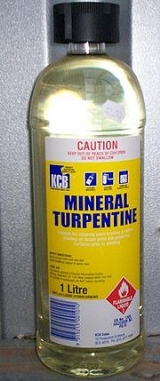
Mineral turpentine
Encyclopedia

Petroleum
Petroleum or crude oil is a naturally occurring, flammable liquid consisting of a complex mixture of hydrocarbons of various molecular weights and other liquid organic compounds, that are found in geologic formations beneath the Earth's surface. Petroleum is recovered mostly through oil drilling...
-based replacement for the vegetable
Vegetable
The noun vegetable usually means an edible plant or part of a plant other than a sweet fruit or seed. This typically means the leaf, stem, or root of a plant....
-based turpentine
Turpentine
Turpentine is a fluid obtained by the distillation of resin obtained from trees, mainly pine trees. It is composed of terpenes, mainly the monoterpenes alpha-pinene and beta-pinene...
. It is commonly used as a paint thinner
Paint thinner
A paint thinner is a solvent used to thin oil-based paints or clean up after their use, although all such solvents have other uses. Commercially, "paint thinner" is usually a name for mineral spirits.Products used as paint thinners include:*Mineral spirits...
for thinning oil-based paint
Paint
Paint is any liquid, liquefiable, or mastic composition which after application to a substrate in a thin layer is converted to an opaque solid film. One may also consider the digital mimicry thereof...
and cleaning brushes, and as an organic solvent in other applications.
Mineral turpentine is a hydrotreated
Hydrodesulfurization
Hydrodesulfurization is a catalytic chemical process widely used to remove sulfur from natural gas and from refined petroleum products such as gasoline or petrol, jet fuel, kerosene, diesel fuel, and fuel oils...
light distillate of petroleum
Petroleum
Petroleum or crude oil is a naturally occurring, flammable liquid consisting of a complex mixture of hydrocarbons of various molecular weights and other liquid organic compounds, that are found in geologic formations beneath the Earth's surface. Petroleum is recovered mostly through oil drilling...
, and consists of a complex mixture of highly refined hydrocarbon
Hydrocarbon
In organic chemistry, a hydrocarbon is an organic compound consisting entirely of hydrogen and carbon. Hydrocarbons from which one hydrogen atom has been removed are functional groups, called hydrocarbyls....
distillates mainly in the C9-C16 range. The material is a colorless transparent liquid
Liquid
Liquid is one of the three classical states of matter . Like a gas, a liquid is able to flow and take the shape of a container. Some liquids resist compression, while others can be compressed. Unlike a gas, a liquid does not disperse to fill every space of a container, and maintains a fairly...
at room temperature
Room temperature
-Comfort levels:The American Society of Heating, Refrigerating and Air-Conditioning Engineers has listings for suggested temperatures and air flow rates in different types of buildings and different environmental circumstances. For example, a single office in a building has an occupancy ratio per...
, and immiscible to water. The liquid is highly volatile and the vapours are flammable. It can be a very dangerous inhalant
Inhalant
Inhalants are a broad range of drugs whose volatile vapors are taken in via the nose and trachea. They are taken by volatilization, and do not include drugs that are inhaled after burning or heating...
.
Mineral turpentine has a characteristic unpleasant odor. Chemical manufacturers have developed a low odor version of mineral turpentine which contains less of the highly volatile shorter hydrocarbons.
Typical composition of mineral turpentine
| Chemical Entity | CAS Number | Proportion (%) |
|---|---|---|
| Low Aromatic White Spirit | 64742-82-1 | > 60 |
| Solvent naphtha (petroleum), light arom. | 64742-95-6 | 20 - 40 |
| Contains < 0.1% w/w benzene | ||
Typical composition of mineral turpentine (low odor)
| Chemical Entity | CAS Number | Proportion (%) |
|---|---|---|
| Low Aromatic White Spirit | 64742-82-1 | 100 |
| Solvent naphtha (petroleum), light arom. | 64742-95-6 | 0 |
| Contains < 0.1% w/w benzene | ||

